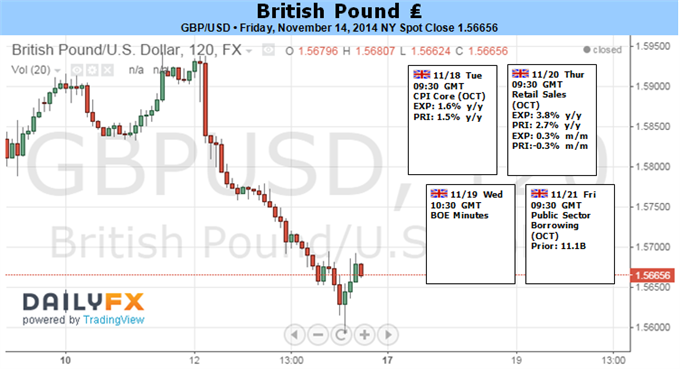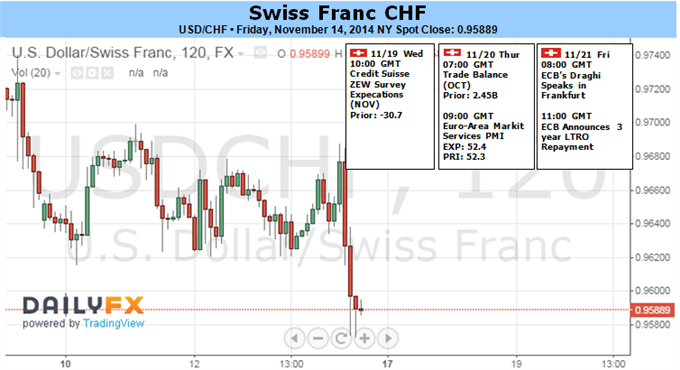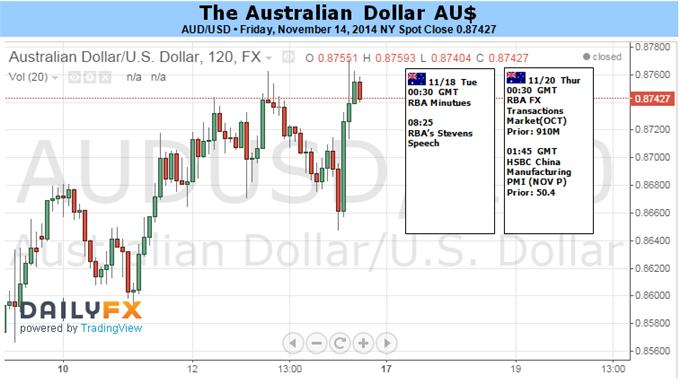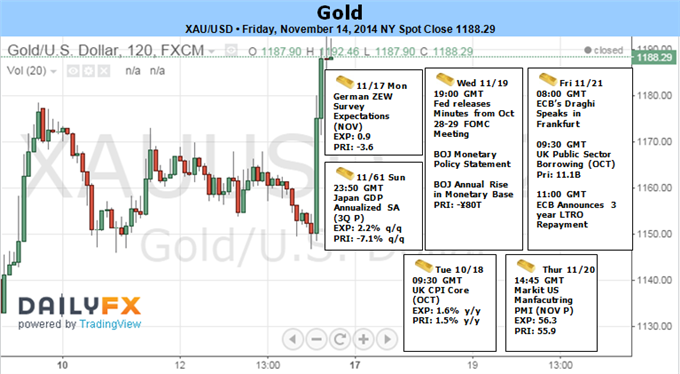Weekly Outlook: 2014, November 16 - 23
Mario Draghi’s speeches, UK inflation data, German ZEW Economic Sentiment, Rate decision in Japan, US Building Permits and FOMC Meeting Minutes, as wee as inflation and employment data. These are the major events on FX calendar. Here is an outlook on the highlights of this week.
Last week, U.S. retail sales edged up 0.3% in October, indicating stronger spending boosting domestic economy. The increase was higher than forecasted. Analysts expect the U.S. economy will expand around 3% next year, the strongest growth rate since the 2007-09 recession. Core sales excluding automobiles also gained 0.3%, beating expectations for a 0.2% gain. Will this trend continue?
- Mario Draghi speaks: Monday, 14:00 & Friday, 8:00. ECB President Mario Dragh is expected to testify before the Committee on Economic and Monetary Affairs, in Brussels and speak in Frankfurt. Market volatility is expected.
- UK inflation data: Tuesday, 8:30. UK inflation dropped to a five-year low of 1.2% in September following 1.5% the prior month. The main price decline occurred in the energy and food sectors. Despite the strong growth in the UK economy, inflationary pressures remain subdued; it is unlikely that the BoE will raise rates before 2015. UK inflation is expected to remain at 1.2%.
- Eurozone German ZEW Economic Sentiment: Tuesday 9:00. Investors’ sentiment plunged in October to its lowest level since November 2012, reaching minus 3.6 points. The ZEW index fell by 10.5 points negative territory, for the first time. Economists expect confidence to remain low over the medium term. Recent disappointing data such as factory orders, industrial production, and foreign trade have contributed to the sharp decline. German economic sentiment is expected to reach 0.9 points this time.
- US PPI: Tuesday, 12:30. Producer prices for finished goods declined in September by 0.1% following an unchanged reading in the previous month. Economists expected a price rise of 0.1%. Meanwhile, core PPI excluding the volatile food and energy sectors came out flat. Unadjusted, the producer price index for final demand rose 1.6% for the 12 months that ended in September. Producer prices are expected to drop again by 0.1%.
- Japan rate decision: Wednesday. The Bank of Japan surprised markets in October while deciding to expand its massive stimulus spending, admitting that economic growth and inflation have not picked up as expected following a sales tax hike in April. BOJ Governor Haruhiko Kuroda announced that the expansion was done to ensure the early achievement of the 2% inflation target and end deflation. Analysts were not expecting further easing measures in such short period.
- US Building Permits: Wednesday, 12:30. US Building permits increased in September 1.5% to an annualized rate of 1.02 million, suggesting the U.S. economy continues to strengthen despite the global slowdown. Building of multifamily projects such as condominiums and townhomes jumped 16.7 percent to an annual rate of 371,000. Work on single-family properties rose 1.1 percent to a 646,000 rate in September from 639,000 the prior month. The positive trend is also evident in factory production and the job market, posting the lowest level of jobless claims in 14 years. US Building permits are predicted to reach 1.04 million.
- FOMC Meeting Minutes: Wednesday, 18:00. The Fed FOMC minutes from the September meeting were mostly dovish. The minutes stressed that the Fed will be lenient in its exit strategy. The focus now is on exit strategy for pulling down the Fed’s balance sheet. Regarding the outlook for the fed funds rate, some noted that markets’ outlook is below FOMC forecasts. Several participants see inflation running below Fed goal for quite some time.
- US Inflation data: Thursday, 12:30. U.S. consumer prices increased mildly in September, showing weak inflation pressures, providing the Federal Reserve ample room to keep interest rates low for an extended period. CPI increased by 0.1% after a 0.2% fall in the previous month. Economists expected a flat reading in September. Sluggish wage growth helped to keep prices nearly unchanged. Meanwhile core CPI excluding food and energy prices, gained 0.1% in September, while the year-on-year change held steady at 1.7%. CPI is expected to drop 0.1% while core CPI is predicted to gain 0.2%.
- US Unemployment Claims: Thursday, 12:30. The Labor Department release showed a rise of 12,000 in initial claims last week, reaching 290K. The increase was larger than expected, but remained below 300,000 for ninth straight week indicating the US job market is stronger than ever. Another good sign was a rise in the number of Americans quitting their jobs under their own volition, suggesting stronger confidence in the labor market condition. The number of jobless claims is expected to decline to 286K.
- US Philly Fed Manufacturing Index: Thursday, 14:00. The manufacturing sector in the Philadelphia region continued to weaken in October, falling to 20.7, after September’s reading of 22.5. However despite the modest decline, Philadelphia manufacturing still shows growth. New orders edged up to 17.3, compared to September’s reading of 15.5; the employment index declined to 12.1, following 21.2 in September; and the six-month outlook dropped to 54.5, compared the precious reading of 56.0. The manufacturing sector in Philadelphia us expected to reach 18.9 this time.


 LinkBack URL
LinkBack URL About LinkBacks
About LinkBacks





 Reply With Quote
Reply With Quote







Bookmarks